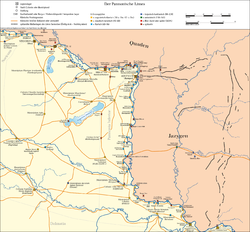Top Qs
Timeline
Chat
Perspective
Danubian Limes
World Heritage Site From Wikipedia, the free encyclopedia
Remove ads
The Danubian Limes (German: Donaulimes), or Danube Limes, refers to the Roman military frontier or limes which lies along the River Danube in the present-day German state of Bavaria, in Austria, Slovakia, Hungary, Croatia, Serbia, Bulgaria and Romania.
This article needs additional citations for verification. (February 2024) |
The Danube was not always or everywhere used by the Romans as the military frontier which was moved north or south in some locations according to military conquests, but it was maintained in many places as a fairly permanent defensive structure for long periods. The border was reinforced with numerous watchtowers, legion camps (castra) and forts (castella). Due to the boggy and dendritic nature of the Danube's river banks no border ramparts were built, unlike the Neckar-Odenwald Limes in Germany. The camps were built in the mid-1st century. Later, under Trajan, the camps, which had originally only been surrounded by earthen embankments, were enclosed by stone walls.
A Roman road, the Danube Way (Latin: Via Istrum) was laid along the limes, which linked the stations, camps and forts as far as the Danube Delta.[1]
In 2021, the western segment of the Danube Limes were inscribed on the UNESCO World Heritage List as part of the set of "Frontiers of the Roman Empire" World Heritage Sites.[2]
Remove ads
Subdivisions
Because of the sheer length of this border, the Danubian Limes is often divided into the following subdivisions:
- Rhaetian Limes, only those elements along the Danube being counted as part of the Danubian Limes.
- Noric Limes
- Pannonian Limes (in Upper and Lower Pannonia)
- Moesian Limes
- The Upper Germanic-Rhaetian Limes between the Rhine and the Danube
- The Noric-Pannonian Limes in present-day Austria
- The Pannonian Limes in present-day Slovakia, Hungary, Croatia and Serbia
- A snapshot of The Moesian Limes of one period in present-day Bulgaria and Romania
Remove ads
Germany and Austria
Summarize
Perspective

The oldest Roman camp in Austria was Carnuntum. Fourteen kilometres away to the west an auxiliary fort (Hilfskastell) was built near Schlögen (today in the municipality of Haibach ob der Donau) in Upper Austria. At that time, the limes ran from Vienna to Linz roughly following the present-day Wiener Straße (B 1).
Because the Danube did not always provide adequate protection, bridgeheads were built on its northern banks against the Marcomanni, such as the one in Stillfried or at the Oberleiser Berg. However, these were cleared again under Marcus Aurelius' son, Commodus, and a seven-kilometre-wide 'death strip' was laid along the Danube.
The increasing number of fortifications that were falling into decay were renovated again under Emperor Valentinian I (364–375) and upgraded to the conform to the latest military tactics. Walls were thickened, and defensive ditches renewed. In addition, towers were built along the walls, such as a watchtower discovered near Oberranna in 1960. These fortifications lasted only another hundred years before the fall of the Roman Empire. In 488 the land of present-day Austria was cleared. The Roman fortifications along the lower courses of the Danube were overhauled once again, especially under Anastasios I and Justinian I. They finally served during Maurice's Balkan campaigns his successor, Phocas, as a basis for larger military operations and some were maintained in the province of Moesia Secunda until the invasion of the Bulgars in 679.
A few defensive towers survive: in Bacharnsdorf in Lower Austria, in Mautern (Favianis) and in Traismauer (Augustiana). In Tulln and Zeiselmauer, too, there are surviving remnants. In the Kürnberg Forest near Linz there are remains of a watchtower from the Roman period.
Legion camps were established in:[3]
Camps (castra) and forts (castella) in Austria from west to east:[3]
- Stanacum (Engelhartszell)
- Ioviacum (Schlögen)
- Ad Mauros (Eferding)
- Lentia (Linz)
- Ad Iuvense (Wallsee)
- Arelape (Pöchlarn)
- Namare (Melk an der Donau)
- Favianis (Mautern)
- Barbaricum (Fels am Wagram – nördlich der Donau)
- Augustianis (Traismauer)
- Asturis (Zwentendorf)
- Comagena (Tulln)
- Cannabiaca (Zeiselmauer)
- Arrianis/Asturis (Klosterneuburg)
- Ala Nova (Schwechat)
- ? (Mikulov-Tschechien)
- Aequinoctium (Fischamend)
- Roman fort, Höflein (Höflein)
- Roman fort, Stopfenreuth (Engelhartstetten)
Remove ads
Lower Pannonia

In 103 AD, Emperor Trajan divided the province of Pannonia into two parts: Pannonia Superior and Pannonia Inferior, or Lower Pannonia. The Lower Pannonia province ran along the eastern side of the Danube, today a part of Hungary, Serbia, Croatia, and Bosnia and Herzegovina. Colonies and towns were built throughout the area on both sides of the Danube, in addition to Roman forts, garrisons, and bases. Some of the most notable were:
- Transaquincum, Contra Aquincum (Pest)
- Matrica (Százhalombatta)
- Gorsium (Tác)
- Vetus Salina (Adony)
- Intercisa (Dunaújváros)
- Lussonium (Dunakömlőd)
- Alisca ad latus (Őcsény)
- Ad Statuas (Várdomb)
- Lugio/Florentia (Dunaszekcső)
- Altinum (Kölked)
- Ad Militare (Batina)
- Ad Novas (Zmajevac)
- Colonia Aelia Mursa (Osijek)
- Teutoburgium (Dalj)
- Cuccium (Ilok)
- Cusum (Petrovaradin)
- Burgenae (Novi Banovci)
- Colonia Singidunum (Belgrade)
Lower Danube


The Lower Danubian Road was built under Emperor Tiberius in the 1st century AD on the right (southern) bank of the river and forts and watchtowers were also built as part of the limes linked by the road. The following Roman forts were the first to be established here during the 1st century:[citation needed]
- Augustae (near the village of Hurlets)
- Valeriana (near the village of Dolni Vadin)
- Variana (near the village of Leskowez)
- Almus (near the town of Lom)
- Regianum (near the town of Kozloduy)
- Sexaginta Prista (near the town of Ruse)
- Dorostorum (near the town of Silistra)
- Ratiaria (near the town of Artschar)
- Novae (near the town of Svishtov)
- Viminatium
- Singidunum (Belgrad)
- Oescus
Remove ads
References
Literature
External links
Wikiwand - on
Seamless Wikipedia browsing. On steroids.
Remove ads



